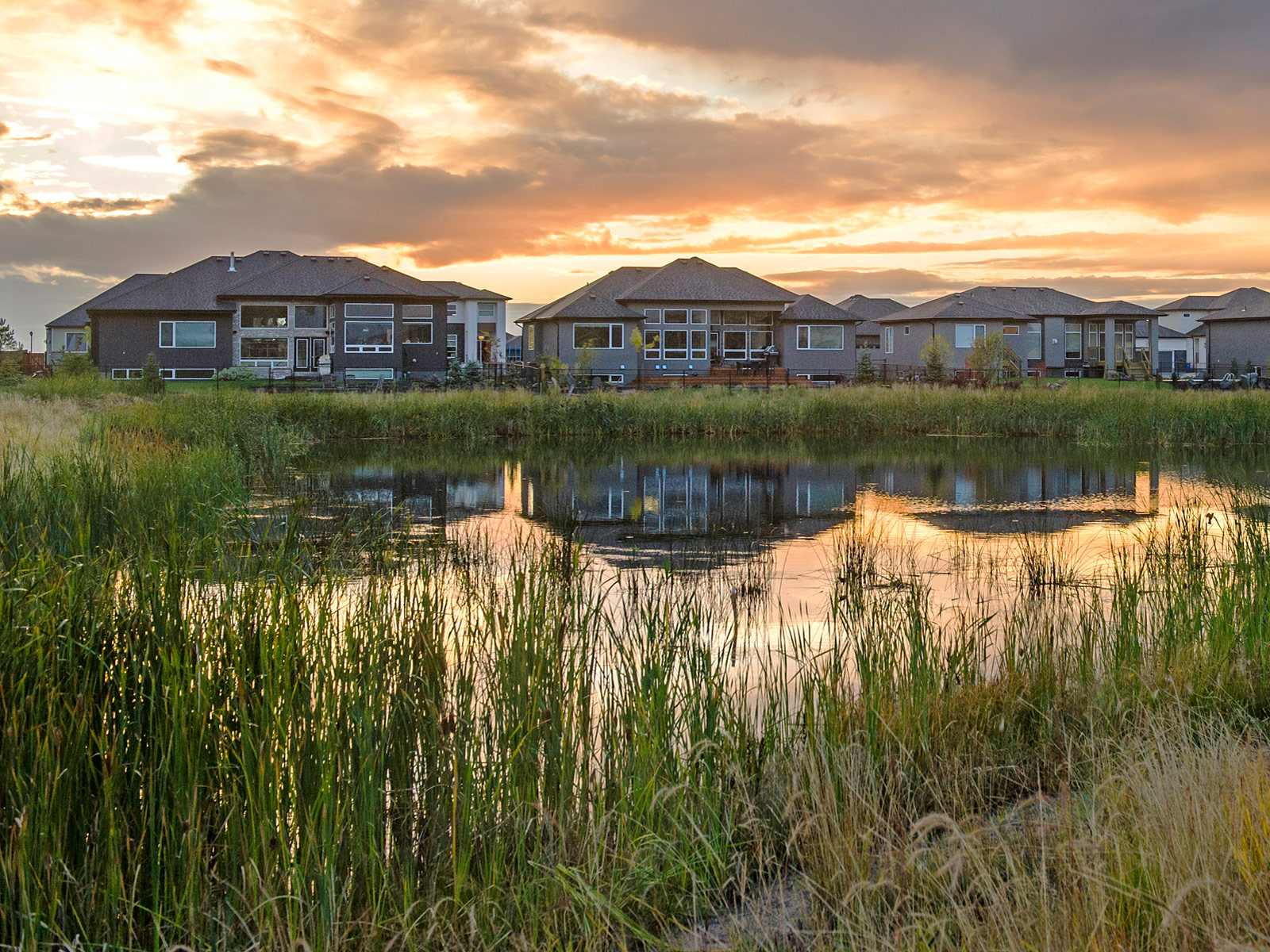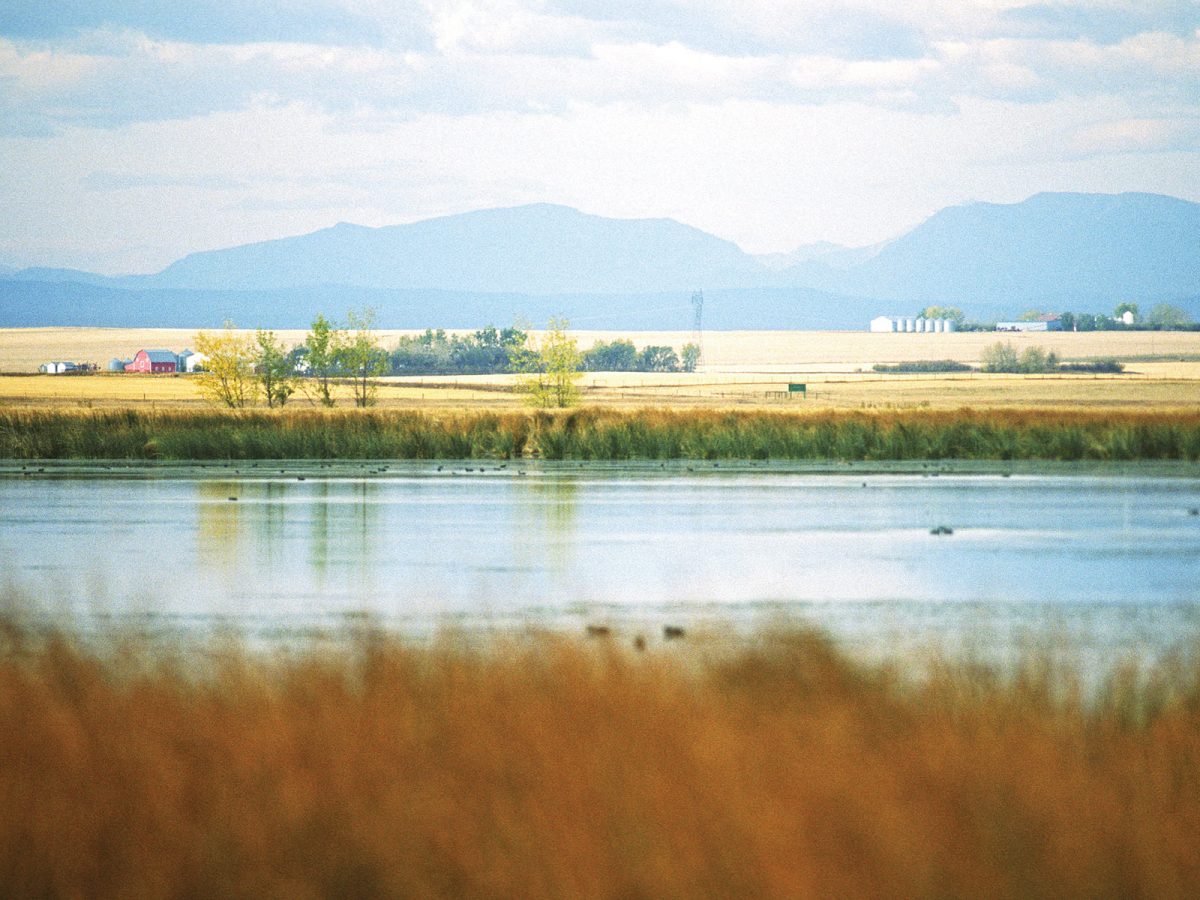The new green scene
Harnessing wetlands as green infrastructure solutions to our water woes

For one weekend every July, the village of St. Pierre-Jolys hosts the National Frog Jumping Championship. It’s part of the annual Frog Follies Festival. The thriving Franco-Manitoban community is also proud of its parks, a new residential compost pickup service and the Trans-Canada Trail that runs along the nearby Rat River. It’s about as green as it gets here. And it’s about to get greener.

©Ryan Quan
Seeing wastewater through a green lens
Standing on a grassy berm overlooking St. Pierre-Jolys’ current wastewater treatment lagoon, Janine Wiebe points to an adjacent muddy field.
“In a few months, this field will be full of heavy equipment,” she says, smiling. The village’s chief administrative officer describes how their wastewater treatment system will expand to include a new tertiary treatment wetland.
Like all communities, St. Pierre-Jolys must anticipate the current and future needs of their wastewater treatment system. Future growth depends on it. Their system needs to remove pollutants, deliver clean water, handle increased volume and cope with the uncertain timing of stormwater events.
Traditional, concrete treatment plants are expensive to build and maintain. St. Pierre-Jolys found a better solution.
Staff from Native Plant Solutions (NPS) proposed the tertiary treatment wetland; a sustainable, cleaner, cost-effective and greener way to reduce nutrient levels in the village’s wastewater.
“In this system, a third cleansing cell – the wetland – is added to the primary and secondary treatment cells to reduce phosphorous levels,” says Glen Koblun, manager of NPS. NPS is a consulting branch of Ducks Unlimited Canada (DUC) and a leader in science-based treatment wetland systems.
“There’s lower maintenance and management costs to this system compared to chemical or mechanical treatment options,” adds Koblun.
The treatment wetland system takes advantage of the natural functions of wetland plants – a process called phytoremediation – that transforms common pollutants into harmless byproducts or essential nutrients. This comes from the sheer amount of biological activity that occurs in a wetland system including sunlight, wind, water, air, plants and soils.
“This project fit our vision,” says Wiebe. “We are leaving a legacy that will make it easier for future generations. It allows room for expansion and will cost less in the long run.”

©DUC
Green infrastructure: it’s only natural
Green infrastructure is a buzz word that’s infiltrating conversations about making communities more resilient to disasters like floods. DUC research scientist Pascal Badiou, PhD, believes green infrastructure is essential. Wetlands, he says, are one of the most powerful systems available to us.
“Traditional built infrastructure such as dry dams or water treatment systems serve an important role but typically address only one issue and come with high maintenance costs,” says Badiou. “Green infrastructure, which includes natural areas, vegetation and wetlands, captures and treats stormwater and runoff at its source. It’s building with nature instead of concrete.”
Wetlands hold rainwater, snowmelt and floodwaters. They filter pollutants, store carbon, replenish groundwater, reduce erosion and provide habitat for wildlife as well as places for people to enjoy the outdoors.
“Other types of flood control are not able to deliver the additional benefits that wetlands provide,” says Badiou, who has conducted extensive research across the Prairies about the role of wetland drainage on water quality and quantity.
Seeing the green light through restoration
Getting people and governments to appreciate green infrastructure can be difficult. In Alberta, it took the devastating floods of June 2013 for the provincial government to reach a watershed moment. Southern Alberta was inundated. Downtown Calgary shut down. These events cost millions of dollars in damage.
The government responded with a number of funding programs to address a wide range of recovery activities, including the Watershed Resiliency and Restoration Program (WRRP). As its name implies, the WRRP aims to improve watershed functions to build greater long-term resiliency to droughts and floods. Resiliency would be improved through restoration, conservation, education and stewardship.
Traditional mitigation projects involve large-scale construction or engineered structures (“grey” infrastructure). Watershed restoration supported by WRRP focuses on natural solutions. This includes conserving and restoring wetlands.
Tracy Scott, DUC’s head of industry and government relations in Alberta, and other DUC staff presented a business case for the use of wetland restoration for flood mitigation in southern Alberta. Their efforts helped inform the government’s development and implementation of the WRRP.
“The expansion of the WRRP program to include natural green infrastructure was an excellent example of how we helped the Government of Alberta align wetland conservation with provincial and societal priorities, including Alberta’s Wetland Policy,” says Scott. “Few people recognize that the new Alberta Wetland Policy represents an important implementation tool to support Alberta’s flood, drought, water quality and biodiversity management goals.”
During the first round of the program’s implementation in 2014, DUC has received $11.6 million to fund restoration of 1,380 acres (558 hectares) of wetlands in flood- and drought-prone areas in the southern part of the province.
“A significant proportion of that money is going directly into the pockets of participating landowners, rewarding them for their contribution to ecosystem services, with the balance being used for the actual restoration work,” says Scott.
This puts the natural power of the landscape to work, instead of relying only on traditional engineered infrastructure,” says Scott. It’s a proactive approach that’s safeguarding the long-term future of water, wildlife and people across the province.
“The WRRP is the first chapter of DUC’s green infrastructure story in Alberta,” says Scott.

©Leigh Patterson
Pairing green with grey
As Alberta has learned, flood control is a key environmental benefit provided by wetlands. But little research exists specific to Ontario. The need to fill information gaps has escalated in recent years as the province has been hit with bigger storms and floods.
In 2016, DUC and several partners conducted research in the Credit River watershed, a densely-populated region vulnerable to extensive flooding. They used a hydrological model that quantified the consequences of wetland loss and gain on flooding under a variety of storm events.
This past fall, the results came in.
Not surprisingly, in modeling scenarios where researchers removed wetlands from the landscape, flooding was worse. When wetlands were restored the intensity of flooding diminished.
The research supports the idea that when combined with built infrastructure like stormwater retention ponds, green infrastructure like wetlands can provide another layer of flood defense. Green infrastructure like wetlands can also reduce the pressure on and extend the life of grey infrastructure.
“The research identifies areas where wetland restoration will have the greatest impact on flood reduction,” says Mark Gloutney, PhD, DUC’s director of regional operations, eastern region. “DUC can work with municipalities, conservation authorities and others to better plan for extreme weather and flooding by helping build up their inventory of natural infrastructure assets, like wetlands.”
Building climate-resilient communities in Ontario will require strategic investments in wetland restoration, says Gloutney. DUC, he adds, “is prepared to come to the table.”

©DUC
Coast to coast: more shades of green
Janine Wiebe is looking forward to the final implementation of her village’s green vision. They plan to add educational signage and trails around the new tertiary wetland site. They also want to invite environmental science students to conduct research there.
As they wait, cities like Moncton, N.B. are reaping the rewards of investing in green infrastructure.
By working with NPS staff, Moncton has integrated wetland-like naturalized stormwater retention ponds into urban developments. These urban wetlands are able to store and filter vast amounts of water, which improve water quality as a result.
Elaine Aucoin, Moncton’s director of environmental planning and management found that these systems are functional, and add to the quality of life for residents. “[Wetlands] look a lot nicer, and provide the community with a place to gather around, unlike dry ponds that are often fenced off, and a waste of space,” says Aucoin.
In March, DUC president Jim Couch recognized the City of Moncton with a special “Ducks Unlimited Canada Order of Conservation” for its wetland conservation leadership.
Leading the green infrastructure revolution on the opposite side of the country, is Gibsons on B.C.’s sunshine coast. The town gained national recognition when the Globe and Mail profiled it for declaring Nature its “most valuable infrastructure asset.” Their 2015 financial statements read: The Town is fortunate to have many natural assets that reduce the need for man-made infrastructure that would otherwise be required. This includes the Gibsons aquifer (water storage and filtration), creeks, ditches and wetlands (rain water management) and the foreshore area (natural seawall).
What gets measured gets managed. So important are these green infrastructure assets, the town made a pioneering decision to include them under the same asset management system as engineered infrastructure.
Walking over a footbridge spanning the spring-swollen Rat River, Wiebe says she understands why Gibsons values the potential of green infrastructure solutions that exist around us.
“Instead of working against nature, we should be working with it.”



